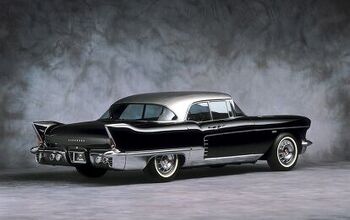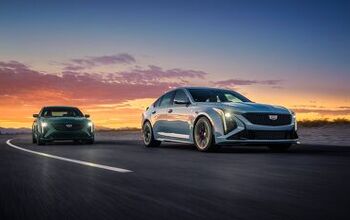Rare Rides Icons: The Lincoln Mark Series Cars, Feeling Continental (Part XLVII)

When the Mark VIII debuted for the 1993 model year with a daring and sleek new body and an interior to match, it was indicative of the forward-looking, modern direction of Lincoln’s personal luxury coupe. This new school of design was evident inside and out: No longer were there acres of velour, tall hood ornaments, and goofy color schemes created “by designers.” Instead focus was on a generous helping of luxury features, high-tech doo-dads, and a singular trim level. Sorry, Mr. Bill Blass.
In addition to its model-exclusive (for two years) Four-Cam V8, Mark VIII arrived standard with dual front airbags and four-wheel ABS brakes. Though those latter two were required to play in the luxury car field in the early Nineties, Mark VIII attempted to stand out with other unique features. First and foremost among them was the new electronic message center, front and center in the dash.
Displaying information on an LCD screen between the center dash vents, the message center was controlled by a row of buttons at the top of the center stack and canted towards the driver. Functionality included a compass, engine oil life readout, and an average fuel economy indicator.
Fuel economy functions continued with a miles to empty indicator, an instant economy readout, and a measurement of how many gallons of premium gasoline remained. Average speed could also be called upon. The message center also contained the trip odometers, of which there were two.
Additionally, an owner could set a distance for a given trip in advance, and then check the distance remaining while underway. All numerical readouts were available in imperial and metric, should a buyer happen to be Canadian. The message center also indicated when there was an issue with the Mark VIII, like a fault with the air suspension or when the door or trunk were left ajar.
While buyers were dazzled by all the information available at their fingertips, they were also coddled by standard leather seats (six-way powered at the front) with power lumbar adjustment. Things like cruise control, climate control, and driver’s seat memory were also standard, among expected features like power windows, locks, and mirrors. Keyless entry was now standard, and exterior locks were illuminated as the domestic luxury manufacturers did in the late Eighties and early Nineties.
Lincoln also provided an upmarket stereo system with a cassette and a large powered antenna. The limited options list included a sunroof that would likely be standard today, as well as automatic dimming mirrors. The stereo could be upgraded to a single CD player, or with a 10-disc changer that resided in the trunk. The nicest stereos in the Mark VIII were provided by JBL. A generously sized car phone was also available.
For the first two model years the Mark VIII existed without any trim levels, and was exclusive in its use of the Four-Cam V8. The ‘95 model year changed all that, as an upmarket trim finally appeared, and the newly rebranded InTech V8 spread to the Continental sedan. Along with those changes arrived a lightly reworked center stack. Most notably there was a new and more ergonomic looking design for the stereo faceplate. From 1995 onward it looked more like a stereo from a Town Car and less like the stereo from an F-150.
The climate control faceplate was also redesigned slightly to include larger buttons that were softer in their appearance. Though it was the same unit as before, the larger buttons matched better with the new design of the stereo. The center stack sprouted a new golden Lincoln logo within its wood trim. The stack had more wood on it than it did prior to 1995, and had a more flush appearance as it curved upward to finish at the information center.
Lincoln resurrected the LSC trim last seen on the 1992 Mark VII in the 1995 Mark VIII. Available from mid-95, the most exciting feature of the LSC was its more powerful engine. A tuned InTech managed 290 horses and 295 lb-ft, both figures 10 more than in the standard Mark VIII that year. Though it used the same four-speed auto as the base model Mark, the LSC used a more aggressive rear axle with a 3.27:1 ratio.
The LSC could be identified from a distance by its dual exhaust, which allowed the free-breathing InTech to manage 60 miles per hour in a claimed 7.5 seconds. For reference, this figure was bested by the Eldorado Touring Coupe (ETC) which managed the feat in 7.2 seconds. The much more expensive Lexus SC 400 beat both of them with a time of 6.7 seconds.
Like the ETC, the Mark VIII LSC stood apart from the standard trim via a selection of special paint colors and LSC exterior badging on the trunk lid. More monochromatic than the base model, the LSC had color-key trim inserts instead of chrome around its exterior. Inside, all LSCs had perforated inserts in their leather seats, and floor mats embroidered with LSC. Continuing its domestic leadership in regard to headlamps, the 1995 LSC brought with it an advancement: High-intensity discharge lights, or HIDs. It was the first domestic car to have such headlamps.
Though its lighting was a step forward, Lincoln took a look backward in 1996 when it created a Diamond Anniversary package to celebrate the company’s 75th anniversary. The last time a Mark offered a commemorative birthday trim was the 1978 Diamond Jubilee edition of the Mark V. That one was a celebration of Ford’s 75th anniversary.
The Diamond Anniversary was mostly about special badging, notably etched into the rear quarter window since no opera window was available. All Diamond Anniversary cars featured all optional equipment as standard and included a mobile phone, directional chrome wheels, moonroof, KBL audio, and Diamond Anniversary embroidered floor mats.
Interestingly, the package could be applied to a base Mark or to an LSC version. There were only two colors available, Silver Frost or Cordovan Metallic. All examples featured Light Graphite leather seats with contrasting Cordovan inserts and logo embroidery.
All 500 or so examples of the Diamond Anniversary came with an absolutely terrible plaque. Made of a dark wood, it featured a large piece of Waterford crystal and was engraved with the original buyer’s name on a golden plate. I’ve found one picture of said plaque here.
Even more terrible than that plaque was what happened to the Mark VIII’s design the following year. In 1997 Lincoln facelifted its PLC in a very controversial and whale-like way. We’ll pick up there next time.
[Images: seller]
Become a TTAC insider. Get the latest news, features, TTAC takes, and everything else that gets to the truth about cars first by subscribing to our newsletter.

Interested in lots of cars and their various historical contexts. Started writing articles for TTAC in late 2016, when my first posts were QOTDs. From there I started a few new series like Rare Rides, Buy/Drive/Burn, Abandoned History, and most recently Rare Rides Icons. Operating from a home base in Cincinnati, Ohio, a relative auto journalist dead zone. Many of my articles are prompted by something I'll see on social media that sparks my interest and causes me to research. Finding articles and information from the early days of the internet and beyond that covers the little details lost to time: trim packages, color and wheel choices, interior fabrics. Beyond those, I'm fascinated by automotive industry experiments, both failures and successes. Lately I've taken an interest in AI, and generating "what if" type images for car models long dead. Reincarnating a modern Toyota Paseo, Lincoln Mark IX, or Isuzu Trooper through a text prompt is fun. Fun to post them on Twitter too, and watch people overreact. To that end, the social media I use most is Twitter, @CoreyLewis86. I also contribute pieces for Forbes Wheels and Forbes Home.
More by Corey Lewis
Latest Car Reviews
Read moreLatest Product Reviews
Read moreRecent Comments
- Amy I owned this exact car from 16 until 19 (1990 to 1993) I miss this car immensely and am on the search to own it again, although it looks like my search may be in vane. It was affectionatly dubbed, " The Dragon Wagon," and hauled many a teenager around the city of Charlotte, NC. For me, it was dependable and trustworthy. I was able to do much of the maintenance myself until I was struck by lightning and a month later the battery exploded. My parents did have the entire electrical system redone and he was back to new. I hope to find one in the near future and make it my every day driver. I'm a dreamer.
- Jeff Overall I prefer the 59 GM cars to the 58s because of less chrome but I have a new appreciation of the 58 Cadillac Eldorados after reading this series. I use to not like the 58 Eldorados but I now don't mind them. Overall I prefer the 55-57s GMs over most of the 58-60s GMs. For the most part I like the 61 GMs. Chryslers I like the 57 and 58s. Fords I liked the 55 thru 57s but the 58s and 59s not as much with the exception of Mercury which I for the most part like all those. As the 60s progressed the tail fins started to go away and the amount of chrome was reduced. More understated.
- Theflyersfan Nissan could have the best auto lineup of any carmaker (they don't), but until they improve one major issue, the best cars out there won't matter. That is the dealership experience. Year after year in multiple customer service surveys from groups like JD Power and CR, Nissan frequency scrapes the bottom. Personally, I really like the never seen new Z, but after having several truly awful Nissan dealer experiences, my shadow will never darken a Nissan showroom. I'm painting with broad strokes here, but maybe it is so ingrained in their culture to try to take advantage of people who might not be savvy enough in the buying experience that they by default treat everyone like idiots and saps. All of this has to be frustrating to Nissan HQ as they are improving their lineup but their dealers drag them down.
- SPPPP I am actually a pretty big Alfa fan ... and that is why I hate this car.
- SCE to AUX They're spending billions on this venture, so I hope so.Investing during a lull in the EV market seems like a smart move - "buy low, sell high" and all that.Key for Honda will be achieving high efficiency in its EVs, something not everybody can do.










































Comments
Join the conversation
Anyone had experience with the 98-03 Jag XJ8? I just had some questions. I know a bit about them but its been ages since I've been near a running one. Thx.
Saw one over the weekend for the first time in years. It was in great shape and had been de-plasichromed and lowered. Looked magnificent.